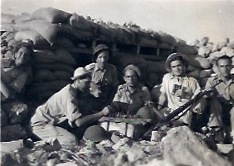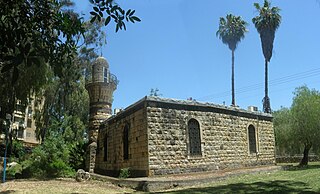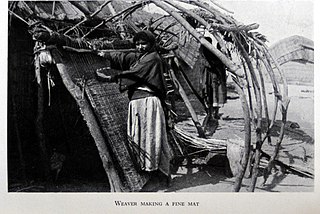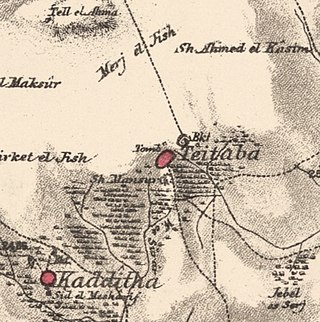
Operation Hiram was a military operation conducted by the Israel Defense Forces (IDF) during the 1948 Arab-Israeli War. It was led by General Moshe Carmel, and aimed at capturing the Upper Galilee region from the Arab Liberation Army (ALA) forces led by Fawzi al-Qawuqji and a Syrian battalion. The operation, which lasted 60 hours, was marked by heavy fighting between Arabs and Jews, and ended just before the ceasefire with the neighboring Arab countries went into effect.

Killings and massacres during the 1948 Palestine war resulted in the deaths of hundreds of civilians and unarmed soldiers.

Safed is a city in the Northern District of Israel. Located at an elevation of up to 937 metres (3,074 ft), Safed is the highest city in the Galilee and in Israel. It is known as the "capital" of the Galilee.
The al-Khisas massacre took place in al-Khisas in Mandatory Palestine on December 18, 1947, near the Syrian border and was carried out by Haganah militiamen, possibly from Palmach. Twelve Arab residents of Al-Khisas were killed, four of them children.

The Palmach was the elite fighting force of the Haganah, the underground army of the Yishuv during the period of the British Mandate for Palestine. The Palmach was established in May 1941. By the outbreak of the 1948 Arab–Israeli War, it consisted of over 2,000 men and women in three fighting brigades and auxiliary aerial, naval and intelligence units. With the creation of Israel's army, the three Palmach Brigades were disbanded. This and political reasons compelled many of the senior Palmach officers to resign in 1950.

Sa'sa' was a Palestinian village, located 12 kilometres northwest of Safed, that was depopulated by Israeli forces during the 1948 Arab-Israeli war. The village suffered two massacres committed by Haganah forces: one in mid-February 1948 and the other at the end of October the same year. Its place has been taken since 1949 by Sasa, an Israeli kibbutz.
The Balad al-Shaykh massacre was the killing of a large number of Arab villagers by the Haganah in the Palestinian Arab village of Balad al-Shaykh hours after the Haifa Oil Refinery massacre during the early stages of the 1947–1948 civil war in Mandatory Palestine. It was one of the largest, and earliest, massacres during the 1948 Palestine war.

Al-Khalisa was a Palestinian Arab village situated on a low hill on the northwestern edge of the Hula Valley of over 1,800 located 28 kilometers (17 mi) north of Safad. It was depopulated in the 1948 Palestine war.
The 1947–1948 civil war in Mandatory Palestine was the first phase of the 1947–1949 Palestine war. It broke out after the General Assembly of the United Nations adopted a resolution on 29 November 1947 recommending the adoption of the Partition Plan for Palestine.

Ein al-Zeitun, also spelled Ein Zaytun, Ein ez-Zeitun, Ain al-Zaytun or Ain el-Zeitun, was a Palestinian Arab village, located 1.5 kilometres (0.93 mi) north of Safed in the Upper Galilee. During the early Ottoman period, Ein el-Zeitun had a mixed population of Muslims and Jews. Later, in the 19th century, it became entirely Muslim. The village's small population and land area as well as its proximity to Safad made it a suburb of the city. In 1945, the village had a population of 820 inhabitants and a total land area of 1,100 dunams. The village was depopulated in 1948, after the Ein al-Zeitun massacre.

'Akbara is an Arab village in the Israeli municipality of Safed, which included in 2010 more than 200 families. It is 2.5 km south of Safed City. The village was rebuilt in 1977, close to the old village destroyed in 1948 during the 1947–1949 Palestine war.
Operation Yiftach was a Palmach offensive carried out between 28 April and 23 May 1948. The objectives were to capture Safed and to secure the eastern Galilee before the British Mandate ended on 14 May 1948. It was carried out by two Palmach battalions commanded by Yigal Allon.

Fir'im was a Palestinian Arab village in the Safad Subdistrict that was depopulated during the 1948 Palestine war. It was first attacked during the 1947–1948 Civil War in Mandatory Palestine on May 2, 1948, by the Palmach's First Battalion during Operation Yiftach. In 1945 the population had been 740.

Jahula was a Palestinian Arab village in the Safad Subdistrict. It was depopulated during the 1947–1948 civil war in Mandatory Palestine on May 1, 1948, by the Palmach's First Battalion of Operation Yiftach. It was located 11 km northeast of Safad.

Qabba'a was a Palestinian Arab village in the District of Safad. It was depopulated during the 1948 War on May 26, 1948, by the Palmach's First Battalion of Operation Yiftach. It was located 6 km northeast of Safad.

Al-Salihiyya was a Palestinian Arab village populated by people traditionally associated with the Ghawarna, a generic exonym denoting inhabitants of the drainage plains of the Hula Valley. It was depopulated during the 1948 War on May 25, 1948, by the Israeli Palmach. It was located in the Safad Subdistrict, 25 km northeast of Safad, at the intersection of the Jordan River and Wadi Tur'an.

Taytaba was a Palestinian-Arab village in the Safad Subdistrict, located 5 kilometers north of Safad. It was depopulated during the 1947–1948 Civil War in Mandatory Palestine in May 1948 under Operation Hiram. In 1945 it had a population of 530 and a total area of 8,453 dunams, 99.8% of which was Arab-owned.

Moshe Kelman was an Israeli military officer. According to the testimony of numerous fellow soldiers, Kelman was responsible for ordering the Ein al-Zeitun massacre.

The 1948 Palestine war was fought in the territory of what had been, at the start of the war, British-ruled Mandatory Palestine. It was the first war of the Israeli–Palestinian conflict and the broader Arab–Israeli conflict. During the war, the British withdrew from the territory and the State of Israel was established, leading to it being known in Israel as the War of Independence.
















